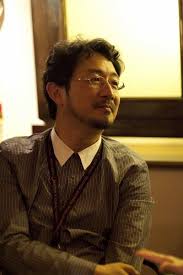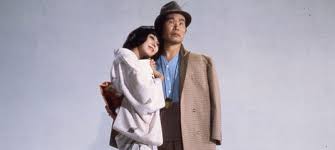ABOUT THE CINEMA SERIES “A MAN IS DIFFICULT”
 In 1996, the movie series Y. Yamada “It’s hard for a man” (“Otoko wa tsuray yo”) got into the Guinness Book of Records as the longest series of films with the same movie star in the title role. The series glorified its author, the actors who starred in it (K. Atsumi, T. Baisho, S. .. Morikawa, H. Dazai, G. Maeda, R. Sato and others), for decades ensured the popularity of the Setiku film studio, the protagonist the series (Torajiro Kuruma) became almost the national hero of Japan, at the scene of the series in the Shibamata district (Katsushika administrative district, Tokyo), where the main events of the film took place, there is a memorial complex for the Setiku film studio dedicated to the series and its to the
In 1996, the movie series Y. Yamada “It’s hard for a man” (“Otoko wa tsuray yo”) got into the Guinness Book of Records as the longest series of films with the same movie star in the title role. The series glorified its author, the actors who starred in it (K. Atsumi, T. Baisho, S. .. Morikawa, H. Dazai, G. Maeda, R. Sato and others), for decades ensured the popularity of the Setiku film studio, the protagonist the series (Torajiro Kuruma) became almost the national hero of Japan, at the scene of the series in the Shibamata district (Katsushika administrative district, Tokyo), where the main events of the film took place, there is a memorial complex for the Setiku film studio dedicated to the series and its to the
creators, near the Sibamata station (Kay private railway line seikanamatasen “) a Torajiro monument appeared, built in 1999 with the voluntary donations of fans of the series, which amounted to 20 million yen. The series is devoted to many publications, there is an ongoing discussion on the Internet about it, information about the work of Y. Yamada is presented on many “home pages”. In general, the movie series “It’s Hard for a Man” became a notable event in the cultural life of Japan in the late 60s and early 90s of the 20th century.
For 27 years (from August 1969 to December 1995), as a rule, two films were released each year, one of which was attached to the summer memorial holidays, and the second to the New Year. The series invariably enjoyed great popularity among the audience, invariably collecting full cinema halls. What is the reason for this popularity? First, the creators of the film accurately captured the needs of the Japanese cinema viewer of the era of rapid economic growth of the country, which for the first time in the difficult post-war years had the opportunity to escape from the problems of physical survival, from hard numbing work and turn to spiritual values. Secondly, Y. Yamada in his series managed to successfully combine the fundamental values of the Japanese cultural tradition and some popular ideas of Western (American) mass cinema (the image of a cheerful and carefree vagabond, a chivalrous attitude to the “beautiful lady”, the idea of Superman), without losing this national identity and having touched the most treasured strings of ethics, aesthetics, Japanese mentality. Thirdly, the movie “It’s Hard for a Man” is a full-fledged entertaining movie that does not deceive the viewer’s expectations, gives him the opportunity to look at himself from the outside, laugh at himself and once again make sure of the enduring beauty and attractiveness of traditional Japanese values and ideals. Fourthly, for the amusement of the public, Y. Yamada managed to create the image of the “Japanese Superman” (Y. Shirai), easily realizing the subconscious desires and aspirations of the average person and, at the same time, being a parody of the image of the superman American mass cinema. Finally, fifthly, the filmmakers found a very good stylistic tone for him: they diluted the gloomy tragedy of Japanese cinema with American frivolity, showing a sense of proportion in everything and finding their inimitable style. Y. Yamada paints post-war Japan with light, intricate colors, creating vibrant, bright, sparkling, colorful visual images resembling paintings by the unrivaled masters of Ukiyo-e, Hokusai and Hiroshige, who managed to embody in their creations the shape, color and rhythm of the Japanese vision of the world.
“It’s difficult for a man” is a dramatic comedy in which comedic, melodramatic, or parody-satirical moments prevail, this is a saga about the search for human happiness, about the Japanese understanding of the beautiful in human relations, this is a kaleidoscope of the beauties of nature in Japan. This work by Y. Yamada celebrates the sincerity and cordiality of the Japanese people, their ability to feel, understand with their hearts, their ability to notice beauty and act in accordance with traditional ideas about beauty. The comedy form of the series does not interfere with serious thoughts about the eternal problems of human life – about love, the search for happiness, about the family and the relationships of its members.
At the end of the 60s, when the movie series Y. Yamada began to be filmed, many negative consequences of Japan’s “modernization” (westernization) began to appear, the reverse sides of the “Japanese economic miracle” began to appear, and attitudes towards the cultural values imposed by the accelerated westernization began to change. Against the backdrop of growing environmental problems, the Japanese began to feel nostalgic feelings for the bygone era of harmony between man and nature, the “lost paradise” of traditional Japanese culture, the times when you could live a leisurely measured life, not knowing the hustle and bustle created by people, day and nightly preoccupied with making money.
In pre-war Japan, there was no place for an emancipated personality, because the whole life of any individual was built in the paradigm of fulfilling a duty to the emperor, state, society, family. Moreover, the personal should be sacrificed to the public.




